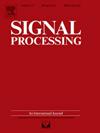利用固有对称性的对称核磁共振波谱非均匀采样重建
IF 3.4
2区 工程技术
Q2 ENGINEERING, ELECTRICAL & ELECTRONIC
引用次数: 0
摘要
对称核磁共振波谱是多维核磁共振波谱的一个重要分支,为生物大分子的结构解析提供了有力的工具。非均匀采样(Non-Uniform Sampling, NUS)是一种有效避免多维核磁共振波谱采集时间过长的策略,它根据NUS采样计划只对几个点进行采样,并通过算法重建缺失点。然而,目前的采样计划无法保持交叉峰的准确恢复,交叉峰是微弱但重要的。在这项工作中,我们提出了一种新的采样计划-对称复制泊松间隙(SCPG),并采用CS(压缩感知)方法进行重建。从理论上证明了当SCPG与CS方法相结合时,对称约束除了具有稀疏性外,还可以隐式实现。模拟和实验数据证实了SCPG在对称核磁共振波谱的NUS重建中优于最先进的2D编织PG。本文章由计算机程序翻译,如有差异,请以英文原文为准。
Non-uniform sampling reconstruction for symmetrical NMR spectroscopy by exploiting inherent symmetry
Symmetrical NMR spectroscopy constitutes a vital branch of multidimensional NMR spectroscopy, providing a powerful tool for the structural elucidation of biological macromolecules. Non-Uniform Sampling (NUS) serves as an effective strategy for averting the prohibitive acquisition time of multidimensional NMR spectroscopy by only sampling a few points according to NUS sampling schedules and reconstructing missing points via algorithms. However, current sampling schedules are unable to maintain the accurate recovery of cross peaks that are weak but important. In this work, we propose a novel sampling schedule— SCPG (Symmetrical Copy Poisson Gap) and employ CS (Compressed Sensing) methods for reconstruction. We theoretically prove that the symmetrical constraint, apart from sparsity, is implicitly implemented when SCPG is combined with CS methods. The simulated and experimental data substantiate the advantage of SCPG over state-of-the-art 2D Woven PG in the NUS reconstruction of symmetrical NMR spectroscopy.
求助全文
通过发布文献求助,成功后即可免费获取论文全文。
去求助
来源期刊

Signal Processing
工程技术-工程:电子与电气
CiteScore
9.20
自引率
9.10%
发文量
309
审稿时长
41 days
期刊介绍:
Signal Processing incorporates all aspects of the theory and practice of signal processing. It features original research work, tutorial and review articles, and accounts of practical developments. It is intended for a rapid dissemination of knowledge and experience to engineers and scientists working in the research, development or practical application of signal processing.
Subject areas covered by the journal include: Signal Theory; Stochastic Processes; Detection and Estimation; Spectral Analysis; Filtering; Signal Processing Systems; Software Developments; Image Processing; Pattern Recognition; Optical Signal Processing; Digital Signal Processing; Multi-dimensional Signal Processing; Communication Signal Processing; Biomedical Signal Processing; Geophysical and Astrophysical Signal Processing; Earth Resources Signal Processing; Acoustic and Vibration Signal Processing; Data Processing; Remote Sensing; Signal Processing Technology; Radar Signal Processing; Sonar Signal Processing; Industrial Applications; New Applications.
 求助内容:
求助内容: 应助结果提醒方式:
应助结果提醒方式:


